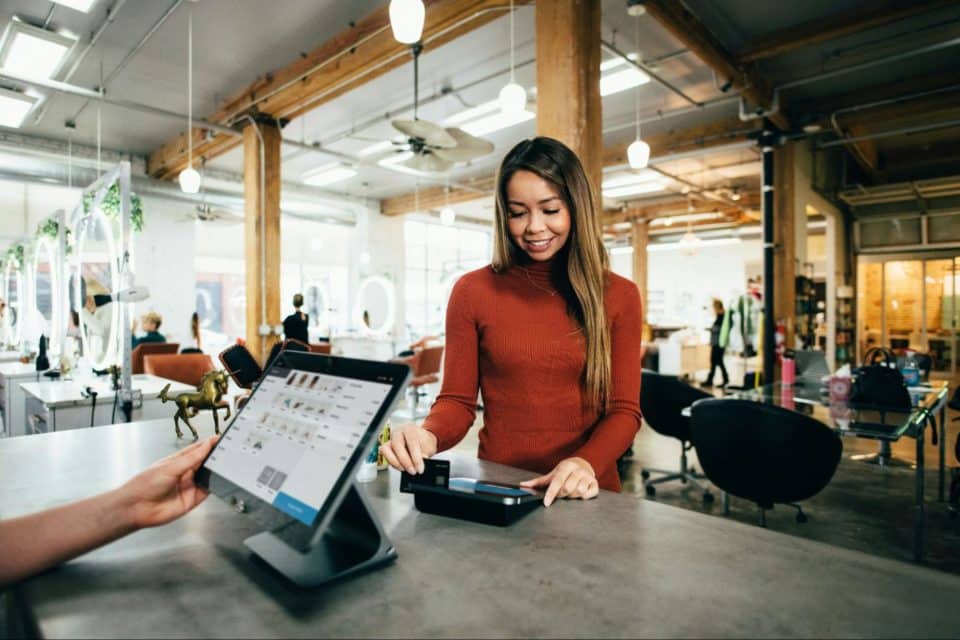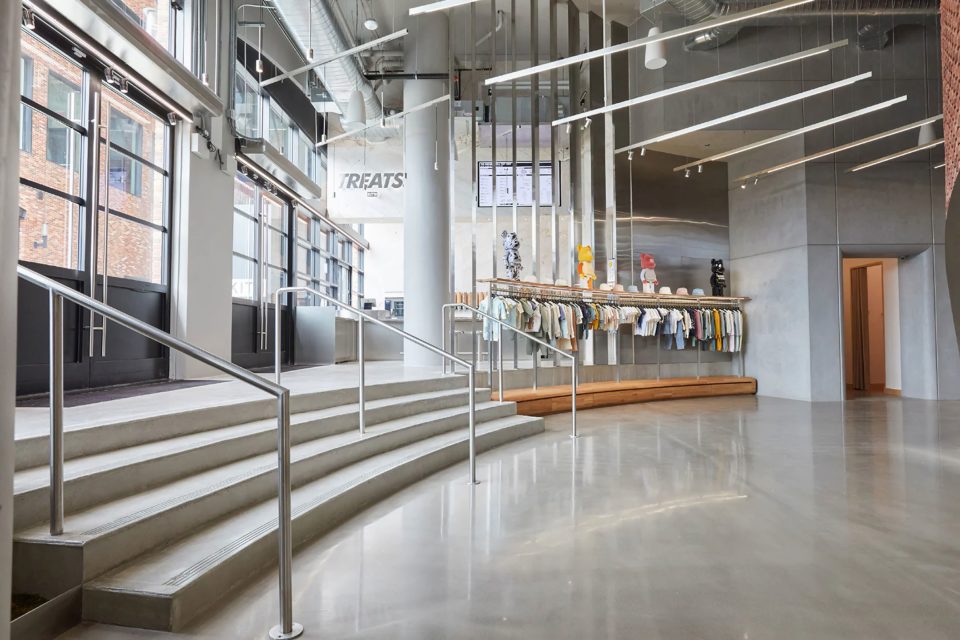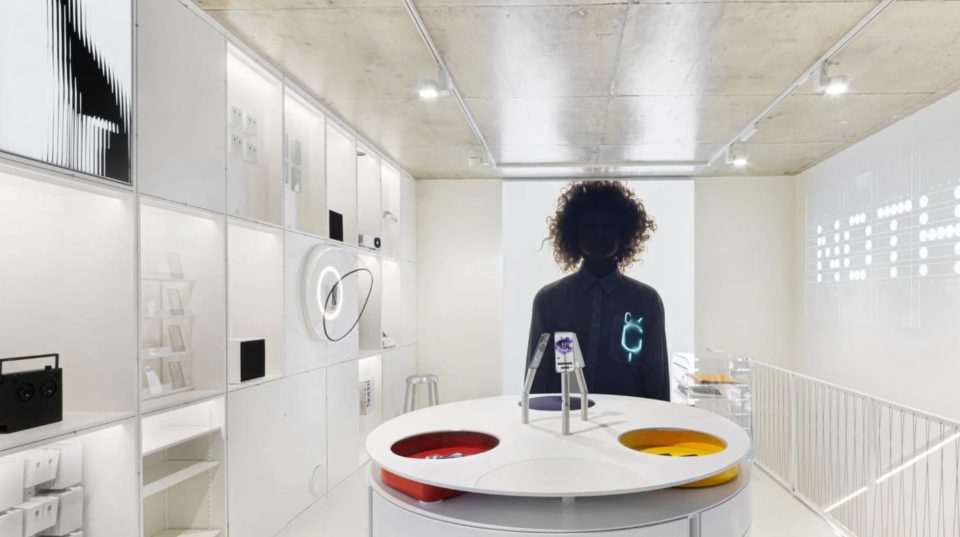Reinventing the wheel: Dalziel & Pow on helping Jaguar Land Rover shake up the car buying model
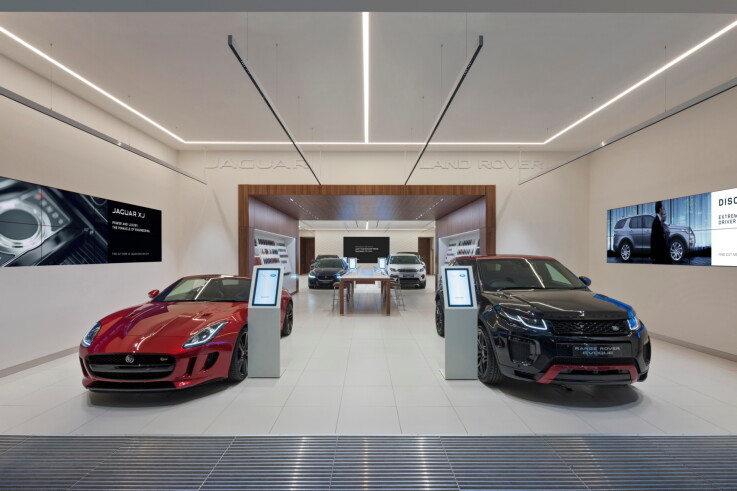
London-based agency Dalziel & Pow (D&P) has an impressive track record when it comes to creating engaging brands and retail experiences. Following on from its groundbreaking work with Rockar, Simon Dixon’s (formerly of Dixon Motors) innovative new platform for car buying, and Hyundai, the company has launched a new digital showroom for Jaguar Land Rover.
Stripping away all of the established elements of the car buying process (salesmen on commission, accompanied test drives, jargon), the new space in East London’s Westfield shopping centre aims to put the customer first, and empower them to buy a car in the way they want.
We chatted to D&P’s Ed Nelson, Associate Design Director, Graphics, and Michelle Bower, Lead Creative Strategist, about the space, creating a seamless journey and how Jaguar Land Rover is broadening its customer base.
Could you explain your involvement in the Jaguar Land Rover project?
Ed Nelson (EN): I run one of the graphic teams within the business and worked on the original pitch for Rockar, which was three years ago now. I’ve been working with Simon (Dixon, founder of Rockar) to deliver on his vision and working with the digital, strategic and environmental teams to help push that through.
Michelle Bower (MB): I’ve been working on this since February and I came in more at the content strategy part, so helping balance the different brands’ stories. I’ve worked closely with Jaguar and Land Rover and Rockar, to make sure that we’re telling the right stories, in the right places in the right way, because there’s quite a lot to say. We want to make sure that the customer is taking away the main things that we want to, when they walk into the space and importantly when they walk away. We’ve both worked very closely with Simon and the Rockar offer to make sure that underpins everything and it doesn’t fight the other two brands.
Why are Jaguar and Land Rover sharing the space (apart from being owned by the same corporation)?
EN: Part of their retail strategy has been to bring those two brands together. So historically, they weren’t sold together, but their new network model has basically brought the two brands together under one roof.
MB: Also, historically they were different audiences. So if you were a Jaguar driver, you wouldn’t be a Land Rover driver, but they talk about having share of driveway now and I think that’s because there’s more crossover in some of the products. There’s a SUV for Jaguar, there’s a SUV for Land Rover, so those price points are blurring a bit more between the two brands.
They both have more in common including the technology and production techniques, so you might learn about a particular technology in a Jaguar and then take away, “oh I didn’t know that was also available in Land Rover too”.
You might come in because of a particular brand or car model you want to look at, but as they are more comparable and compatible, the experience can help change preconceptions of the other brand and car models as well.
How does Rockar works with these auto brands?
MB: I would describe Rockar as a brand agnostic platform that underpins the car brands. They’re committed to turning car buying on its head. All three are trying to help you buy a brand new car. Jaguar and Land Rover have an ambition to help people find that perfect car, and Rockar can help you do this and take away the pain, as it were.
Is it correct that staff (known as ‘angels’) aren’t on commission?
MB: Yes, we think it demystifies all of your preconceptions of buying a car. So things like ‘someone’s going to sit next to me when I take the test drive’. No, you can go and do it on your own. ‘Someone is on commission, they’re just pushing a sale and they’re trying to meet their target’. No, half of these people don’t have a driving license. They’re just here to help you find the right car. In terms of the purpose of Rockar, the experience delivers on that.
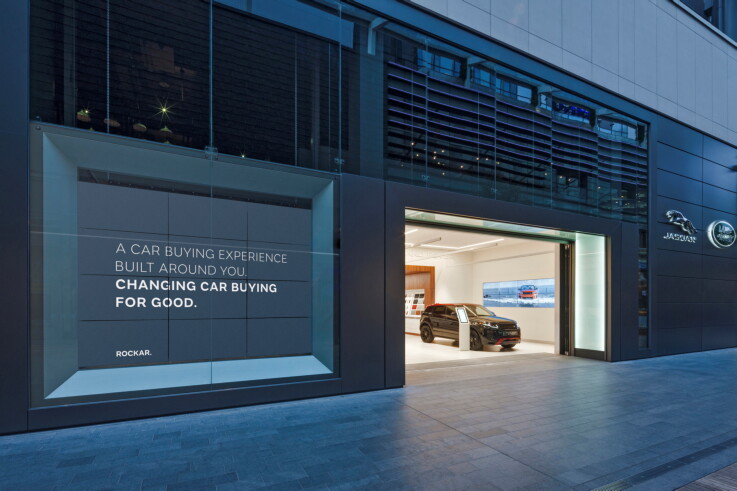
Establishing a new platform
Can you talk me through the process that you went through to create your aspect of this new Jaguar/Land Rover space?
EN: We were approached back in November last year by Simon. We helped him do that with our background, helping him get to market in the first place. The actual process itself breaks down into three key work stages. The first being define – what we do is get to understand the brands, the sector, the customer, any barriers to entry, any barriers to want to purchase and then we couple this with understanding the brand’s vision and ambition. This gives us a really rounded platform to work from and understand what are the key messages, what are the key stories that we need to tell and the products that we want to have in the space. We have to understand what the problem is that we’re overcoming and what the opportunities are.
Then we move into the create stage, which is where we begin to bring that to life. So we start to look at the planning principles, how are we going to put product into the space? What the fit and finish is, the materiality of the scheme. Then we go in to deliver which is where we start to do our drawings and help actually get the environment built.
MB: From day one on define we have a representative from environments, from communication, from digital and from strategy — so we’re all hearing the same things at the same time and we’re all influencing what that define vision is. So it’s less of a ‘I do my bit’ and then I hand it over and Ed does his – all of us from our separate points of view are challenging all three clients. A lot of it is that one of us might think ‘that’s a great insight, I’m going to take that into comms’, but we’re constantly overlapping and feeding that back into other disciplines as well. So from day one all the way to delivery it’s been all of the teams inputting.
EN: We take all of that definition and then we underpin it with a platform that puts the customer in control, with no sale pressures and stigmas, we can then create a scheme where, as Michelle says, “Those disciplines can produce a solution that’s unique to Jaguar Land Rover.”
MB: Also, something that I’ve quite enjoyed about this particular project is that they’ve given us permission to push back against them and say “you know we don’t have to behave in a typical way”. Sometimes you might get carried away – there’s a lot of exciting stories to tell and we have to rein back and just say, “we need to tell the benefit not the feature.” There’s a lot of exciting features with a lot of these cars and that comes back to some of our learnings of say less, but really push through the benefits, not the features, so that the customer can take away the messages that interest them.
In the define stage, was it more complicated because you had three brands to represent? How did you navigate all of that?
MB: I wouldn’t say it was complicated. I think there’s been a lot of open dialogue. We’ve just had to mediate and facilitate and make sure that we’re all clear that we’re doing the right thing for the customer. I think you can be quite close to your brand and I think we’re there to make sure it’s balanced and that we’re doing the right thing and the experience is delivering on what we all set out to do. Also, part of our define process, gives everyone an opportunity to feed in and to push back as well. From there we all sign it off.
EN: The thing is Jaguar and Land Rover are accustomed to sitting under the same roof. So we weren’t putting them in a position where they didn’t already feel comfortable. The challenge is that at the time they weren’t using a lot of digital communications within the space, so the storytelling wasn’t as in-depth as perhaps ours is in Hyundai Rockar, Stratford, although that is beginning to change. Getting them to be confident in telling stories in a way that we thought was best for the customer was a journey for them.
MB: Some newer car models might have more stories than older models and we would constantly be making sure that it was equally weighted between both brands and then the car range under them.
Can you tell me more about any key moments going through those three stages? Were there any big insights that you had?
MB: If you think about what Rockar has done, they’ve taken on an entire sector in saying there’s another way to buy a car, but they’ve done it in a way that is an open platform. So the brands can get on-board and I think, as separate brands, Jaguar and Land Rover have their own positioning. I think there are a lot of things that are changing in the sector in response to customer expectations, and I think the timing is right for all three of them to work together and to experiment in this store format.
In terms of the big learnings from the first Rockar iteration, I think it was the fact that it was perceived that you have to buy a car a certain way, you take a test drive and then you go to the finance options, and you step through these processes. With Rockar it was the fact that people were impulse buying car, because the price made it comparable and accessible and that people were buying without test drives and the fact that you could still buy out of hours, happily. I think for us, the insights were around the different behaviours when you appear in a shopping environment with a retail mindset. Your customers will tell you, “I can shop like this elsewhere” or “I want to shop like this, today”. It is behaving differently in a different environment.
EN: I think one of the things for us, which gave us a great deal of security and confidence in how we’re expressing the concept, was the remarkable results that Hyundai had had. That’s really compelling to anyone that you really explain it to. I think once you define what the possible could be – the brands were very happy to get on-board. It’s not a hard sell when you look at the measurement of success of Hyundai.
For example, we had 92% brand conversion with Hyundai, so 92% of purchasers hadn’t considered buying Hyundai before. We shifted their customer from a 56 year old male to a 39 year old female. That sort of shift in your customer base is quite impactful, especially when you think about it within the automotive space, which typically is seen as a very sort of male orientated sector.
How was the Hyundai concept tested before they moved into Westfield?
EN: Westfield was the second iteration of Hyundai, the first iteration was in Bluewater (shopping centre in Kent).
I think that the fundamental thing was no-one was selling cars online – you couldn’t buy a car unassisted, on a browser from home. So Simon made the platform and made it robust and then came to us with the platform and said, “How do I introduce this into a physical space?” Our understanding of people and a new era of customer and what they’re looking for, and the fact that they’re in a space which has massive footfall and people are in a shopping mode, felt like it was a recipe for success. Everything about it was compelling – place, high footfall, the people, car-selling experts that weren’t on commission, the process, the antithesis of going to a network dealer and it’s a frictionless purchasing experience where I can value a car in 30 seconds and then buy a new car in five minutes.
Those four elements are really interesting and really compelling for any retailer if you can do that, that’s great, the fact that he was first to market, even better. So we had a lot of traction in the press and the fact that there was this interchangeable in-store, online purchase process where there was no pressure. It felt like all of the stars had aligned really and it was an ambitious, bold move and one that was sort of looked at sideways by the automotive industry.
I think the idea is to put the customer in control and empower the customer and that makes good retail sense. All of those elements, the people, the place, the price, the process, it facilitated that.
MB: I guess it was always going to be a calculated risk for whoever the first brands were. But I think so much of it is Simon Dixon is very compelling. He’s an expert, he’s worked in the automotive industry for very long and I think his story is very interesting. He still wants to help people buy cars that are right for them. He just knew that the model wasn’t quite working.
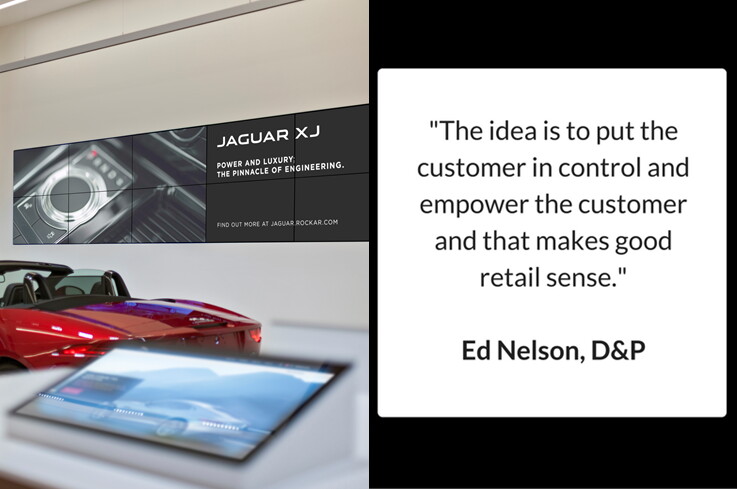
A different customer journey
How are Hyundai and Jaguar Land Rover customers different?
EN: We don’t really look at them that way, to be honest. We look at where they are and what that customer base is. So the 42 million people that walked through Westfield last year, those are our customers. We talk about the brands through the brands’ language but we want to democratise car buying really, and we’re not saying we’re only aiming at that person over there because what we’re doing is empowering the customer to be able to enter into these brands in a way that they perhaps didn’t think they were allowed or were able. We just want to be able to make it easy for anyone to get involved in this sector and these brands. I think we’re customer agnostic and that we let the customer make the decision. It’s all about the benefits to them — service while you shop, test-drive on your own, do it from home or in-store. It’s not a prescribed journey by any sense.
Can you tell me more about the out-of-hours sales element?
EN: You can be walking through the store with your family or your friends and be attracted by “what’s a car doing here” and “My goodness is that the price?” You can start your journey in that space. But say, your partner or your friends, need to leave – you can leave, go home, and pick up that journey back at home and share it with your other decision makers within the household. It gets you started, or alternatively, you might have seen some media and home-started that journey and then the next time you walk through the mall, which is probably one of your weekly visits, you can then go and kick the tyres and have a really good look.
MB: You might be going to Westfield to go the cinema or to go out in the evening at the casinos, restaurants you know, a lot of other things to do. For example, in the Hyundai store, the shutter line is behind the first car, so you can be walking through the shopping center when technically all the shops are closed, but still go and interact with the car, interact with the screens and be self-serving almost, through the digital touchpoints and then take it away.
Does the typical customer journey have moments that link the online and offline?
EN: They use the same platform. The fundamental thing is what you’re doing in-store, is exactly the same as what you would be doing at home. It’s not like an in-store app and on online site for home. It’s exactly the same back-end and front-end. So you can pick up that purchase journey seamlessly from home, on your mobile or in-store.
The car finder, which is the piece that empowers the customer, is the same throughout. You can go on, value your old car immediately by putting in your registration number and then when you start to browse the new vehicles, it will tell you how much cheaper it is to run that new vehicle against your existing vehicle. Then you can start to select and configure and save that if you’re in-store or save it if you’re at home and take that with you, wherever you are. It’s just always on you. Then you can arrange a test drive if you decide you want to do that and pick a time and a date that suits you from home, the bus on in-store. You can take yourself out on a drive and then if you’re really happy, you can then choose the flexible payment plan that best suits you.
MB: Giving you all the finance options means there’s no need to haggle, all the numbers are there. You can keep re-configuring, if ‘I put down this much deposit’ or if ‘I want to spend this much per month’. You’re in control of the numbers and there’s no better deal. In terms of continuity, you’ll never have ‘deal of the day’. It’s just these are the prices.
EN: Once you start to use the car finder and start putting in your deposit and how much you can afford each month it then delivers what you can get as opposed to being told what they think you should have. We have secret shoppers walking into car dealerships and they go, “how much have you got to spend?” Not – “What sort of vehicle are you looking for?”, “Do you have a family?”, “What do you do?” And the fact that Rockar starts to present the vehicles for you in a way that starts to match your finances means that you’re in control.
Also, the fact that you don’t have to talk to anybody, if you don’t want to – it’s brilliant. The fact that if you do talk to someone, they’re not going to try and sell you mats, trim and talk you in a language you don’t understand and want to convert a sale because they need to make money out of you, is even more refreshing.
It’s really interesting to read that the space has been influenced by fashion brands. Are there particular brands you looked to?
MB: It’s more about the context that we fit in, the fact that our store fits along best-known fashion brands. I guess we’re inspired by the fact that people are in shopping mode and these high and low-end shops are side-by-side, next to restaurants, next to cinemas, these kinds of experiences. We’re inspired by the fact that we’re engaging in a fashion and lifestyle context, so we’re not next to all the other car brands for example. Customers are very savvy about brand and experience and want more than just something to buy. If you think of things like when we’re in a shopping mode, you’re window shopping, you’re browsing. For some people it’s just something to do as opposed to going to spend money, it’s social and you’re with other people, you’re meeting there and it’s quite multifunctional.
Window shopping, browsing, fitting room experiences – those are the comparisons that we’ve been inspired by. So if you think of the fitting room, for me, that’s where I sell it to myself. I’m trying it on, I’m daydreaming a little bit and it should be the same when you’re trying a new car. This is going to be a part of your life, where is your life taking you? Who are you going to spend time with in this car? So, you should be doing that on your own, not with someone peppering you with facts and figures. We’ve taken inspiration from how people want to shop and the sort of experience they have and who they want to have that experience with.
EN: There’s nothing worse than when you walk into a store and you just want to browse and one of the members of staff is just on your shoulder and you walk out. If someone came up to you with ten pair of jeans in their arms unsolicited and starts saying, “these are the best jeans for you and I can give you a great deal on these today,” you would run a mile. So that sort of behaviour has influenced our thinking around the service design for example.
MB: We’re now seeing people impulse buying cars. I think with some of the finance offers, the price points are getting down to being comparable with designer jeans or buying a pair of shoes, people are making that comparison for themselves because of the context that we’re sitting in. It’s like when you buy a mobile phone, the monthly number in isolation seems very high and when you start comparing it to buying coffee or going to the cinema and actually you justify it to yourself, somebody isn’t selling it to you.
EN: When you can buy a small car for less than a hundred pounds a month, suddenly you stop to think very differently about owning a vehicle.
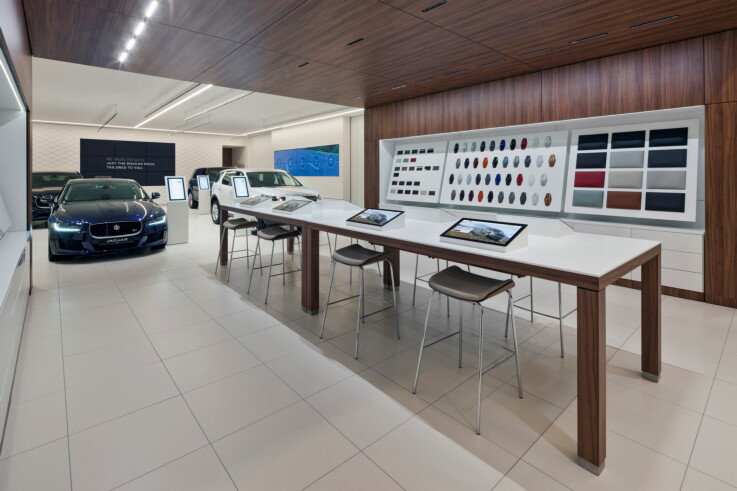
Disrupting the future of car buying
How far do you think this model can go?
MB: The exciting thing about this is that we’re working across a lot of different sectors at the moment and the one thing they all have in common is that customers have never been more demanding and more willing to have experiences with brands, not just to spend their money with them but to spend time with them. In terms of future format, I think that would be wherever the customer behaviours, needs and wants are going. High footfall locations definitely help, because you have a bigger audience and in our case here, people are in shopping mode, they’re open to browsing, they’re open to hanging out with the brands that they haven’t considered before, but I think we’re excited about how we could adapt, scale and stretch the format.
If you think something like Rockar, turning car-buying on its head could give us license to be quite experimental, but it all depends on the right brands and what problem we’re solving. It really depends on the brand’s problem, and also where I think the customer behaviour is going because of the bigger trends like the sharing economy and access without ownership. It’s always evolving and it is a bit of a moving goalpost. But we’re really excited by the fact that the brands are having these conversations and it is about that brand, not just what they sell.
EN: I think that one of the most interesting things about this is if you think that your mobile phone could be the world’s smallest car showroom. Do we have to rely on the physical space? Maybe we don’t, maybe it’s just about calls-to-action within the environment that push you to the most simple and with-you channel. I think the beauty of it is scaleability and that’s really exciting. How and what it will appear like in two to three years’ time? Bear in mind that this didn’t exist three years ago. It’s going to be about solving the problem at hand at the time.
MB: It may be that the brands have a particular business challenge, but also technology and innovation is changing the customer needs. Brands are having to respond – what’s exciting is how should these brands be behaving in the future, because it’s not just going to be about selling stuff, it’s going to be about helping you update or modify or personalise or swap or share. We’re taking quite a traditional business model of a brand selling you a product, but we’re layering in experiences and then we’re moving towards helping people move better or live better. I think that’s the challenge all big brands are facing at the moment. How are we engaging people and how are we helping them beyond just selling them something?
In terms of commitment to customers, not only is it a space where you can browse and buy on your terms, it is integrating future service as well. With Hyundai, I can drop off my car keys while I’m shopping and it can get serviced, and similar services will be woven into the Jaguar Land Rover experience as well. It might be that I’ve already preordered my vehicle – I can pop in, I chat someone and they can remote link me to their service centre. So it’s a hub for peripheral services as well. It’s not come in and keep selling, it’s actually keep coming back, how can we help you, future needs, learning new things. It’s not behaving like a pop-up – I think part of this is we need to reassure customers that it’s a brand behaving differently but it’s a brand that you trust.
EN: I think that’s really interesting because with the new finance offers that are available, so PCP (Personal Contract Purchase) and PCH (Personal Contract Hire), it is very much a circular purchase journey because you exchange your vehicle, you upgrade. It’s very much like the iPhone. I haven’t moved my phone; I just get the next one when it comes out. I’m with them for the journey and that’s very much what’s happening with the cars. Those finance packages do keep you engaged with them and being front of mind and being where I need you for the ongoing relationship is very important. You fundamentally break the relationship if you move out of these spaces.
How often will you speak to Rockar to assess the space and see whether it needs tweaking or updating?
EN: We’re a brand partner with Simon and we are constantly evolving. It’s a relationship that’s gone on for over three years and we talk weekly.
MB: As part of our design define, create and deliver, we’ll be with him in the space, talking through it, talking to customers, but also looking at content and how that evolves over time and how the space can do more than just sell. What’s the invitation for customers to come back? What else can happen in this space? So, that is an ongoing conversation.
What do you think is the next era of engaging brands?
MB: We’ve never wanted more from the brands we interact with than we do now, because other people are setting the bar really high. We have different Engaging Brands topics that we talk about, one is, time well spent. So we’re helping brands say “how else can you give over your space, so that people hang out with you not just spend with you?” New transactions is another, because everything is getting commoditised, what else do I get? Do you teach me stuff? Again, it’s that interaction; if I spend time with you what else do I get?
The human touch is important, it’s the Angels in our store that can cut through the cynicism, because people will come in and go, “yeah, but you know, I can’t afford it.” Or “yeah, I bet they’re on commission” We really do believe in the people in this environment as well and that we should always have a human face. You tend to buy a car during a life stage – moving out of town, having a child or downsizing. We’ve just got to be front of mind the rest of the time, we can’t presume that everyone’s in car buying mode. So it’s showing that you’re there long term, not just when you want to sell something.
Brands behaving differently, we also work with clients that are being pretty brave and experimental at the moment, trying different format strategy, such as Mamas & Papas trying something that’s unbranded in 144, where the space is also a hangout for parents.
Also, we’re seeing online “pure players” like Missguided who understand the value of the physical space, so it’s going both ways really. It’s really exciting because we’ve got clients like Jaguar, Land Rover and Rockar who are being brave and we’re helping them do the right thing for their customers.
Experience the best of London’s retail spaces with one of our Trend Tours. Find out more here.

